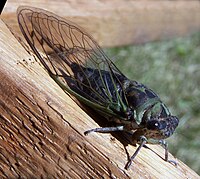
Photo from wikipedia
Predation is one of the significant biotic mortality factors reducing the insect pest population as functional response and the numerical response of the predator are the key factor regulating the… Click to show full abstract
Predation is one of the significant biotic mortality factors reducing the insect pest population as functional response and the numerical response of the predator are the key factor regulating the population dynamics of predator prey species. This study is aimed to evaluate the functional response of all the developmental stages of Scymnus coccivora Ayyar (Coleoptera: Coccinellidae) against the different densities of cotton mealybug, Phenacoccus solenopsis (Tinsley) (Hemiptera: Pseudococcidae) and the numerical response of female predator. Experiments were carried out in controlled environment laboratory conditions at 25 ± 1 °C temperature, 60 ± 5% relative humidity and photoperiod of 16 h. Number of eggs consumed, number of eggs laid and the Efficiency of Conversion of Ingested food (ECI) were recorded daily. Results from the study revealed that all the developmental stages of S. coccivora exhibited a Type II response. Different parameters such as attack rate (a’), handling time (Th) and the maximum rate of predation were estimated using Roger’s random attack equation and Holling Disc equation in which Rogers random attack equation was found best fit. Female has shown the highest attack rate (a’) followed by IVth instar grub, male, IIIrd, IInd and Ist instar grub. With low handling time, IVth instar grub has shown maximum predation rate of 76.40 per day followed by female (75.86), male (58.79), IIIrd (22.84), IInd (19.65) and Ist instar grub (15.39). The numerical response increase was curvilinearly related to different prey densities with the highest number of eggs (11.8 ± 3.44) produced at highest prey density (160). The Efficiency of Conversion of Ingested food (ECI) was highest (64.49 ± 8.03) at prey density of 10. Understanding the factors that lead to variation in functional response of predator in natural population will advance our understanding of the effects of predation on individual and the effectiveness of coccinellid predators as biocontrol agent against cotton mealybug.
Journal Title: Saudi Journal of Biological Sciences
Year Published: 2021
Link to full text (if available)
Share on Social Media: Sign Up to like & get
recommendations!